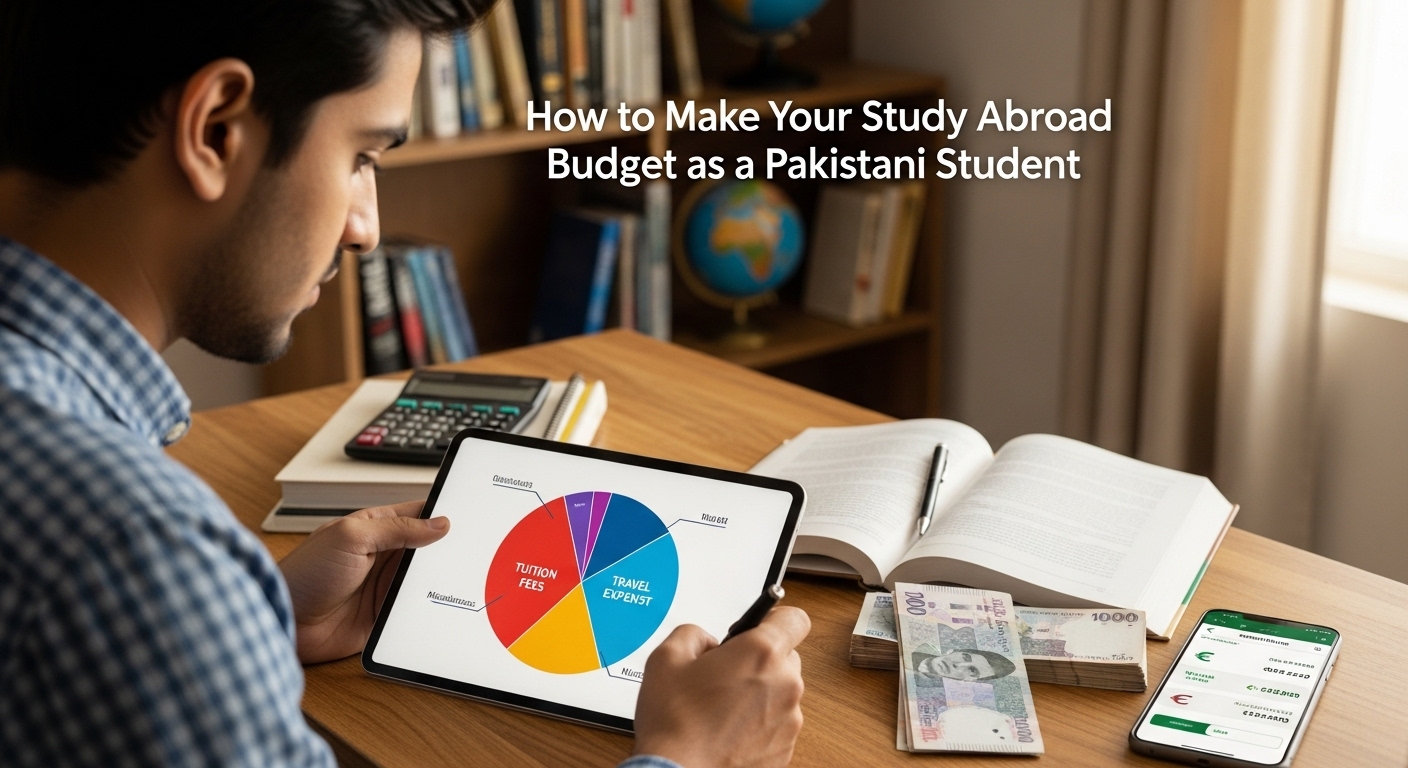Studying abroad is a dream for many Pakistani students, offering unparalleled opportunities for personal growth, academic excellence, and global exposure. However, realizing this dream requires meticulous planning, especially when it comes to finances. A well-structured budget is your compass, guiding you through the various expenses and ensuring you stay on track without unnecessary stress.
As a Pakistani student, you’ll navigate unique challenges, from currency fluctuations to specific remittance regulations. This guide is designed to be your one-stop resource, breaking down every aspect of creating and managing your study abroad budget, from the moment you start planning in Pakistan until you settle into your new life overseas.
Understanding the Core Components of Your Study Abroad Budget
Before diving into the numbers, it’s crucial to understand the main categories of expenses you’ll encounter. Think of your budget as having two major phases: pre-departure costs incurred in Pakistan, and post-arrival costs in your study destination.
Pre-Departure Expenses in Pakistan
These are the initial costs you’ll face before even stepping on the airplane. Many students underestimate these, leading to early financial strain.
1. Application and Testing Fees
- University Application Fees: Most international universities charge an application fee, typically ranging from $50 to $150 USD per application. If you’re applying to multiple universities, this can add up quickly. Check each university’s official website for their specific fees.
- English Proficiency Tests (IELTS/TOEFL): IELTS and TOEFL are widely accepted. The IELTS fee in Pakistan is usually around PKR 50,000 to PKR 55,000, while TOEFL fees are comparable, often around $200-$250 USD, payable in PKR.
- Standardized Tests (GRE/GMAT/SAT): If your program requires tests like GRE (for postgraduate studies, often for STEM or humanities) or GMAT (for business programs), factor in their costs. The GRE General Test fee in Pakistan is approximately $220 USD, while the GMAT is around $250 USD. SAT is required for undergraduate studies in some countries, costing around $100-$150 USD.
- Preparation Material: Don’t forget the cost of study materials, online courses, or coaching classes for these tests. This can range from a few thousand to tens of thousands of PKR.
Local Context Tip: Test fees in Pakistan are often paid in PKR at the prevailing exchange rate, which can fluctuate. Be prepared for slight variations.
2. Visa Application and Related Fees
- Visa Application Fee: This varies significantly by country. For example, a US student visa (F-1) fee is around $185 USD. A UK student visa often costs around £490. For Schengen countries (like Germany or France), a student visa might be around €75-€90. These are typically paid in PKR at the embassy or consulate’s specified exchange rate.
- Biometrics: Many countries require biometric data (fingerprints, photos), which might incur a separate, small fee.
- Medical Examination: Some countries, like Australia or Canada, require a medical examination from a designated panel physician in Pakistan, which has its own cost, usually in the range of PKR 10,000-20,000.
- Document Translations and Attestations: You’ll need official translations and attestations of academic documents, birth certificates, and sometimes financial statements. This can be done through authorized translation services and attested by MOFA (Ministry of Foreign Affairs) or HEC (Higher Education Commission) in Pakistan. Costs vary per document.
Common Mistake: Assuming visa fees are fixed. They can change without much notice, so always check the official embassy website or VFS Global (if applicable) for the latest figures.
3. Travel Expenses
- Airfare: Flight costs from Pakistan vary greatly depending on the destination, airline, and time of booking. Booking well in advance often secures better rates. Consider indirect flights if direct ones are too expensive.
- Travel Insurance: While some universities include health insurance, travel insurance for the journey itself is a good idea. This covers unforeseen events like lost luggage or flight delays.
- Initial Local Transport: Budget for a taxi or public transport from the airport to your initial accommodation.
Real-World Tip: Look for student discounts on flights offered by various airlines or travel agencies in Pakistan.
Post-Arrival Expenses in Your Study Destination
These are the ongoing costs that will form the bulk of your budget once you’ve settled into your new country.
1. Tuition Fees
- University Website: The most reliable source for tuition fees is the official university website. Look for “international student fees” or “tuition fees” sections.
- Program Variation: Fees vary significantly by program (e.g., engineering might be more expensive than humanities), level (undergraduate vs. postgraduate), and institution (public vs. private).
- Scholarships and Aid: Actively search for and apply to scholarships, grants, and bursaries. These can significantly reduce your tuition burden. Many universities offer specific scholarships for international students or students from developing countries.
Challenge: Currency conversion. Always calculate tuition fees in PKR based on the current exchange rate and factor in potential fluctuations. The State Bank of Pakistan (SBP) allows remittances for educational purposes up to $70,000 USD per student per calendar year, which covers most tuition and living expenses. However, you need to provide documentary evidence to your bank.
2. Accommodation
- University Accommodation: Often more affordable and convenient for first-year students, but space can be limited. Apply early.
- Shared Apartments/Rooms: Renting a room in a shared apartment with other students is a popular and cost-effective option. Websites or student forums are good places to find these.
- Private Rentals: Generally the most expensive but offer more privacy.
- Location Matters: Accommodation in major city centers is significantly more expensive than in suburbs or smaller towns. Consider commuting distances and public transport costs.
Anticipate: You might need to pay a security deposit (often one to two months’ rent) upfront, which is a significant initial cost.
3. Food and Groceries
- Cook at Home: The most economical way to eat. Learn simple recipes before you leave Pakistan.
- Groceries: Shop at local supermarkets. Look for student discounts or loyalty programs if available.
- Eating Out: Limit dining out, as it can be very expensive. Save it for special occasions.
- Student Meal Plans: Some universities offer meal plans, which can be convenient but might not always be the cheapest option.
Local Context Tip: If you’re going to a country with a large Pakistani or South Asian diaspora, you might find specific stores selling familiar ingredients, often at reasonable prices.
4. Transportation
- Public Transport: Buses, trains, trams, and subways are usually the most affordable. Research student passes or weekly/monthly travel cards.
- Walking/Cycling: If your accommodation is close to campus, walking or cycling can save money and keep you fit.
- Ride-Sharing/Taxis: Use these only for emergencies or when public transport isn’t available, as they are significantly more expensive.
Challenge: Some cities have complex fare structures. Take time to understand them upon arrival.
5. Health Insurance
- University-Provided Plans: Many universities have mandatory health insurance plans for international students, which are often added to your tuition fees.
- Private Insurance: If not provided by the university, you’ll need to purchase a private health insurance plan that meets the country’s visa requirements. Research reputable providers and compare policies.
Important: Do not compromise on health insurance. Even a minor illness or injury can lead to massive bills.
6. Personal Expenses and Utilities
- Utilities: If you’re renting privately, you’ll pay for electricity, gas, water, and internet. These can fluctuate based on usage and season.
- Phone and Internet: Get a local SIM card with a student-friendly plan. Unlimited data plans might be more expensive, so consider your usage.
- Textbooks and Supplies: While many resources are online, you might need to buy some textbooks or stationery. Look for used books or university library resources.
- Clothing: Factor in clothing, especially if you’re moving to a country with different climate requirements than Pakistan.
- Personal Care: Toiletries, haircuts, and other personal grooming items.
- Entertainment and Socializing: Allocate a small budget for leisure activities, meeting friends, and exploring your new city. This is crucial for your mental well-being and integration.
- Emergency Fund: Crucially, always have an emergency fund for unforeseen circumstances like medical emergencies, sudden travel, or job loss. Aim for at least 3-6 months of living expenses.
Common Mistake: Underestimating personal expenses. What seems like a small daily expense can add up significantly over a month.
Creating Your Detailed Study Abroad Budget
Now that you know the components, let’s put it all together into a practical budget.
Step 1: Research Your Destination’s Cost of Living
- University Websites: Many universities provide estimated living costs for international students on their websites.
- Embassy/Government Websites: Official government sites (e.g., UK Visas and Immigration, Australian Department of Home Affairs) often state the minimum funds required for living expenses for visa purposes. This is a good starting point.
- Student Forums and Blogs: Read experiences from Pakistani students already studying in your desired location. They offer practical insights into daily expenses.
- Cost of Living Calculators: Many international education platforms provide tools to estimate costs based on your destination.
Practical Instruction: Don’t just look at national averages. Focus on the specific city or region where your university is located.
Step 2: Calculate All Pre-Departure Costs
| Expense Item | Estimated Cost (PKR) |
|---|---|
| University Application Fees (e.g., 3 universities × $100 = $300) | 80,000 – 90,000 |
| IELTS/TOEFL Fee | 50,000 – 55,000 |
| GRE/GMAT Fee (if applicable) | 60,000 – 65,000 |
| Test Preparation Materials/Coaching | 10,000 – 50,000 |
| Visa Application Fee | 50,000 – 100,000 |
| Medical Examination (if required) | 10,000 – 20,000 |
| Document Attestation/Translation | 5,000 – 15,000 |
| Airfare (One-way) | 150,000 – 350,000 |
| Travel Insurance | 5,000 – 15,000 |
| Initial Cash for Arrival (up to $5,000 USD, endorsed on passport) | 1,400,000 – 1,500,000 |
| Miscellaneous (passport application, new luggage, etc.) | 10,000 – 30,000 |
| Total Estimated Pre-Departure Costs | Add up all the above |
| Tip | Add 10–15% buffer for unforeseen expenses |
Step 3: Estimate Your Annual/Semester Costs Abroad
| Expense Item | Estimated Cost (per year/semester) |
|---|---|
| Tuition Fees | UK: £15,000 – £25,000 USA: $20,000 – $40,000 Canada: CAD 15,000 – 30,000 |
| Accommodation (monthly × 12) | UK: £400 – £800/month → £4,800 – £9,600/year USA: $600 – $1,200/month → $7,200 – $14,400/year Canada: CAD 500 – 1,000/month → CAD 6,000 – 12,000/year |
| Food/Groceries (monthly × 12) | UK: £200 – £400/month → £2,400 – £4,800/year USA: $300 – $600/month → $3,600 – $7,200/year Canada: CAD 250 – 500/month → CAD 3,000 – 6,000/year |
| Transportation (monthly × 12) | UK: £50 – £100/month → £600 – £1,200/year USA: $80 – $150/month → $960 – $1,800/year Canada: CAD 60 – 120/month → CAD 720 – 1,440/year |
| Health Insurance (annual) | UK: £300 – £600 (IHS fee) USA: $300 – $800 Canada: CAD 300 – 800 |
| Personal Expenses (monthly × 12) | UK: £100 – £200/month → £1,200 – £2,400/year USA: $150 – $300/month → $1,800 – $3,600/year Canada: CAD 100 – 200/month → CAD 1,200 – 2,400/year |
| Textbooks/Supplies (annual) | UK: £200 – £500 USA: $300 – $800 Canada: CAD 250 – 700 |
| Miscellaneous/Buffer | 10–15% of total |
| Total Estimated Annual/Semester Costs | Add up all the above (in respective foreign currency) |
| Tip | Convert the final total to PKR using a realistic exchange rate. Always use a slightly higher rate than the market to account for fluctuations. |
Step 4: Identify Your Funding Sources
- Family Savings/Support: For many Pakistani students, family contributions are the primary source. Discuss with your family their capacity and commitment. Ensure they are comfortable with the amount and duration of support.
- Scholarships and Grants: This is a crucial avenue. Apply for as many as you qualify for, both merit-based and need-based. Look for scholarships specifically for Pakistani students, country-specific scholarships (e.g., Chevening for UK, Fulbright for USA, DAAD for Germany), and university-specific scholarships.
- Student Loans: Explore educational loans from banks in Pakistan or international lenders. Banks like HBL, NBP, MCB, and others offer student loan schemes. Understand the interest rates, repayment terms, and collateral requirements.
- Part-time Work (if permitted): Many countries allow international students to work part-time (usually 20 hours/week during term time, full-time during breaks). This can significantly offset living expenses. However, do NOT rely solely on this, especially for visa purposes, as it’s not guaranteed income.
Local Context Challenge: Securing bank loans in Pakistan often requires significant collateral. Start this process early as it can be time-consuming.
Step 5: Create a Monthly Budget and Track Expenses
- Budgeting Apps: Use mobile apps (many free ones available) to track your income and expenses.
- Spreadsheets: A simple Excel or Google Sheet can be very effective.
- Categories: Break down your spending into categories like rent, food, transport, utilities, personal care, entertainment, etc.
- Review Regularly: At the end of each week or month, review your spending against your budget. Adjust as needed.
- Stick to a Limit: Set a strict weekly or monthly spending limit for discretionary expenses and try not to exceed it.
Common Mistake: Not tracking small expenses. Those daily coffees or snacks add up faster than you think.
Managing Your Funds from Pakistan
Remitting money from Pakistan involves specific regulations and processes. Understanding these is vital.
Remittance Regulations from Pakistan
- Authorized Dealers: Only Authorized Dealing branches of commercial banks in Pakistan are allowed to remit foreign exchange for studies abroad.
- Annual Limit: The SBP allows remittances up to $70,000 USD (or equivalent) per student per calendar year for tuition fees, living expenses, and other university dues.
- Required Documents: You will need:
- Application Form (e.g., Appendix V-82) filled by student/parent/guardian.
- Copies of CNIC/Form ‘B’ of the student and CNIC of the parent/guardian.
- Copy of student’s passport.
- Admission letter from the foreign educational institution.
- Letter/Cost Sheet from the foreign educational institution showing a break-up of expenses (tuition, living, insurance, etc.).
- Documentary evidence for application/processing charges (if remitting separately).
- Direct to Institution: Tuition fees and other university dues are generally remitted directly to the educational institution’s account via SWIFT or telegraphic transfer.
- Living Expenses: Living or miscellaneous expenses can be sent to the student directly.
- Initial Cash: Students can carry up to $5,000 USD (or equivalent) in cash, which will be endorsed on their passport. This is for immediate post-arrival needs.
- Advance Tax: Be aware that advance tax may be applicable on all remittances made for studies abroad as per prevailing tax laws. Consult your bank or a tax advisor in Pakistan.
Key Takeaway: Start the remittance process well in advance, as banks may take a few days to process the transaction, especially for large sums.
Currency Exchange Rates
- Track Rates: Use reliable financial news sources or bank websites to monitor daily exchange rates.
- Transfer Timing: If possible, transfer funds when the PKR is relatively strong against your target currency, but don’t delay essential payments hoping for a better rate.
- Hedging (for larger sums): For very large tuition payments, some financial advisors might suggest hedging strategies, but this is complex and usually not applicable for individual students.
Consideration: The interbank rate is different from the open market rate. Banks will use their own selling rate for foreign currency, which is usually higher than the interbank rate.
Saving Strategies and Tips for Pakistani Students
Being smart about your spending can make a big difference.
Before You Go
- Apply for Scholarships Aggressively: This is your best chance to reduce overall costs. Don’t limit yourself; apply to diverse scholarships.
- Improve English Skills: A higher score on IELTS/TOEFL can sometimes open doors to better scholarship opportunities or even slightly lower tuition fees at some institutions.
- Learn Basic Cooking: Knowing how to prepare meals will save you a fortune on food.
- Sell Unused Items: Declutter your home and sell items you no longer need to raise some extra cash.
- Work and Save: If you have time before your departure, consider taking on a temporary job in Pakistan to build your savings.
- Buy Essentials in Pakistan: Items like basic toiletries, some over-the-counter medicines, or even a good quality jacket (if going to a cold country) might be cheaper in Pakistan.
While You’re There
- Cook at Home: As emphasized, this is the biggest money-saver. Plan your meals and buy groceries in bulk if possible.
- Use Student Discounts: Always ask if there are student discounts for public transport, museums, cinemas, restaurants, or shops. Get a student ID card if it offers such benefits.
- Public Transport: Rely heavily on public transport. If safe and feasible, consider walking or cycling.
- Explore Free Entertainment: Many cities offer free museums, parks, or cultural events. University campuses often have free activities for students.
- Part-time Work: If your visa allows, a part-time job can significantly supplement your living expenses. However, prioritize your studies.
- Second-hand Items: Look for second-hand textbooks, furniture, or electronics. University buy/sell groups or local charity shops are great resources.
- Manage Utilities: Be mindful of electricity, gas, and water usage, especially in colder climates. Turn off lights, unplug chargers, and take shorter showers.
- Budget Phone Plans: Opt for budget-friendly phone plans, possibly prepaid, with limited data if you rely on Wi-Fi on campus or at home.
- Avoid Impulse Buying: Give yourself a cooling-off period before making non-essential purchases.
- Limit International Calls/Data: Rely on free messaging and calling apps like WhatsApp, Telegram, or Google Meet to stay in touch with family in Pakistan.
Common Challenges and How to Overcome Them
Even with careful planning, you might face hurdles. Here’s how to navigate them:
Unexpected Expenses
Challenge: An unforeseen medical issue, an emergency trip home, or a sudden rise in living costs.
Solution: This is where your emergency fund comes in. Aim to have at least 3-6 months of living expenses saved up. Communicate immediately with your family if a major unexpected expense arises that exceeds your emergency fund.
Currency Fluctuations
Challenge: The Pakistani Rupee depreciates against your host country’s currency, making remittances more expensive.
Solution:
- Budget with a slightly higher exchange rate than current.
- Keep a small buffer in your foreign currency account.
- If possible, parents can send larger sums less frequently (within SBP limits) to reduce transaction costs and mitigate minor fluctuations.
Overspending
Challenge: The excitement of a new country leads to excessive spending on dining out, shopping, or travel.
Solution:
- Stick to your monthly budget rigidly.
- Track every expense, no matter how small.
- Find a budgeting buddy (another student) to keep each other accountable.
- Distinguish between needs and wants.
Homesickness and Social Pressures
Challenge: Feeling lonely and spending money on activities to cope, or feeling pressured to keep up with friends’ spending habits.
Solution:
- Find free or low-cost social activities.
- Join student clubs and societies.
- Be honest with friends about your budget constraints. True friends will understand.
- Focus on your studies and personal growth, which are free!
Conclusion
Making a comprehensive study abroad budget as a Pakistani student might seem daunting, but it’s an empowering step towards realizing your academic aspirations. By meticulously planning your pre-departure and post-arrival expenses, understanding remittance regulations, and adopting smart saving habits, you can ensure a financially stable and stress-free journey.
Remember, this isn’t just about numbers; it’s about setting yourself up for success. A well-managed budget allows you to focus on your studies, explore new cultures, and make the most of your incredible international experience. Start planning today, involve your family, and embark on this exciting chapter with confidence!
Resources
- State Bank of Pakistan (SBP) website for foreign exchange regulations.
- Official embassy or consulate websites of your target country for visa fees and requirements.
- University official websites for tuition fees and estimated living costs.
- British Council, USEFP (United States Educational Foundation in Pakistan), DAAD (German Academic Exchange Service) websites for scholarship information.
- Reputable international education platforms and consultants (e.g., IDP, Edify Group) for general guidance and cost estimates.
- Online currency converters (e.g., Google Finance) for exchange rates.
- IELTS and TOEFL official websites for test fees and registration.
- ETS (Educational Testing Service) website for GRE and TOEFL information.
- GMAT official website for test details.
- Travel insurance providers in Pakistan.
- Pakistani commercial banks (HBL, NBP, MCB, etc.) for student loan schemes and remittance services.
- UKCISA (UK Council for International Student Affairs), Canada.ca (Immigration, Refugees and Citizenship Canada), Study in Australia websites for international student work regulations.




